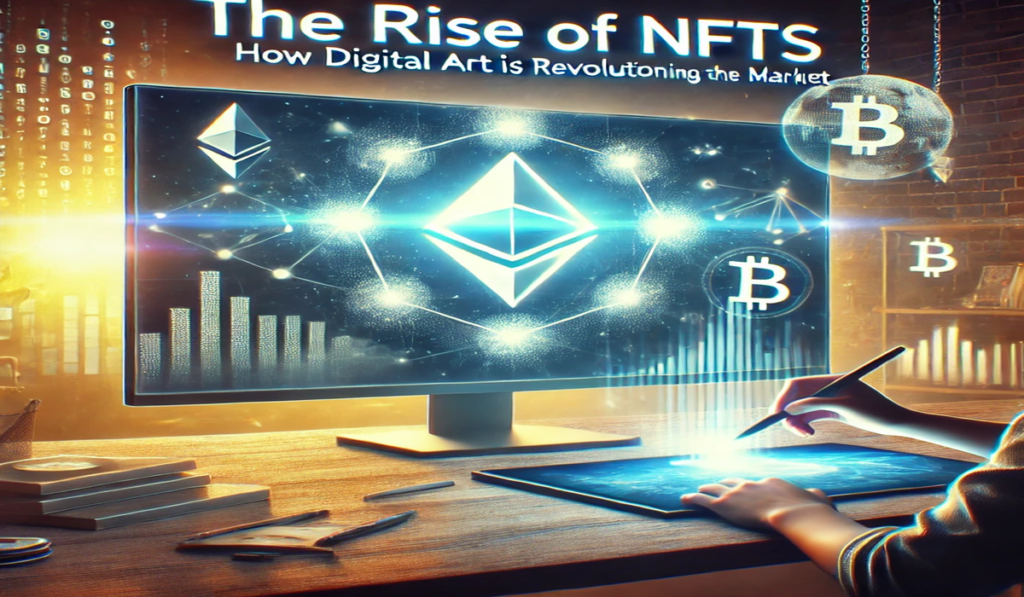The art world has undergone a radical transformation with the advent of NFTs (Non-Fungible Tokens). These blockchain-based digital assets have created new opportunities for artists, collectors, and investors. From multi-million-dollar digital artworks to exclusive collectibles, NFTs have disrupted traditional art markets, bringing both excitement and controversy. But what exactly are NFTs, and how are they changing the digital art landscape?

Understanding NFTs: A Digital Revolution
NFTs are unique cryptographic assets stored on a blockchain, ensuring authenticity and ownership. Unlike cryptocurrencies such as Bitcoin or Ethereum, which are interchangeable, NFTs are non-fungible, meaning each token is one of a kind. Artists can tokenize their work, selling digital art with proof of authenticity, removing the risk of forgery and replication.
How NFTs Are Changing the Art World
- Empowering Artists with Direct Sales
Traditionally, artists have relied on galleries and auction houses to sell their work, often losing a significant portion of their earnings to middlemen. NFTs allow artists to directly connect with buyers via online marketplaces, ensuring they receive full compensation for their art. - Royalties and Continuous Earnings
One of the key advantages of NFTs is the ability to embed smart contracts that ensure artists receive royalties on future resales of their work. This ongoing revenue stream is a game-changer for digital artists who previously had no way to profit from secondary market sales. - Global Accessibility and Exposure
Digital platforms like OpenSea, Rarible, Foundation, and SuperRare have made NFT art accessible to collectors worldwide. Artists no longer need to rely on physical exhibitions; they can showcase their work to a global audience instantly.
The Boom of NFT Marketplaces
Several NFT marketplaces have emerged as leaders in the industry, providing a platform for artists and collectors to engage in NFT transactions. Some of the most notable include:
- OpenSea – One of the largest and most diverse NFT platforms.
- Rarible – A decentralized marketplace allowing creators to mint and sell NFTs.
- SuperRare – Focused on high-end digital art.
- Foundation – A community-driven platform for digital artists.
Record-Breaking NFT Sales and Celebrity Involvement
The rise of NFTs has been marked by high-profile sales and celebrity endorsements. Some of the most notable include:
- Beeple’s “Everydays: The First 5000 Days” – Sold for $69.3 million at Christie’s.
- CryptoPunks – A collection of 10,000 algorithmically generated characters, some selling for millions.
- Bored Ape Yacht Club (BAYC) – A popular collection owned by celebrities like Eminem and Snoop Dogg.
- Celebrity NFTs – Stars like Paris Hilton, Snoop Dogg, and Lindsay Lohan have launched their own NFT collections, increasing mainstream adoption.
Challenges and Controversies
Despite their popularity, NFTs face several criticisms:
- Environmental Concerns – The Ethereum blockchain, which powers most NFTs, consumes a significant amount of energy. However, solutions like Ethereum 2.0 and eco-friendly blockchains like Solana are addressing this issue.
- Market Volatility – NFT values fluctuate drastically, making them a risky investment.
- Plagiarism and Copyright Issues – Some artists have found their work stolen and minted as NFTs without their permission.
The Future of NFTs in Art and Beyond
NFTs are more than just digital art; they are expanding into gaming, virtual real estate, ticketing, and the metaverse. Platforms like Decentraland and The Sandbox allow users to buy virtual land as NFTs, while gaming companies integrate NFTs for in-game assets.
As technology advances, NFTs are poised to reshape multiple industries beyond art, ensuring that digital ownership and provenance become essential aspects of the digital economy.
Conclusion
The rise of NFTs marks a new era for digital art, giving creators unprecedented control over their work and providing collectors with verifiable ownership. While challenges remain, the potential of NFTs in revolutionizing the art world and beyond is undeniable. As innovation continues, NFTs are set to play a pivotal role in the future of digital creativity and commerce.